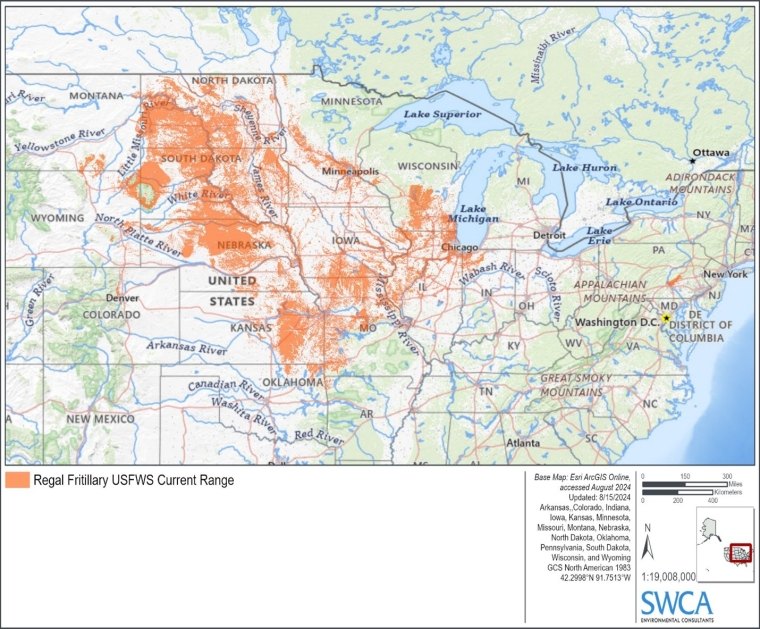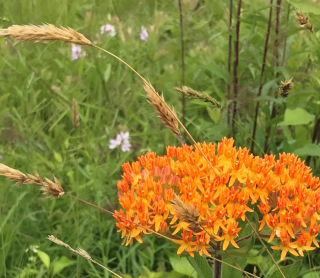The regal fritillary (Argynnis idalia) is a large non-migratory butterfly historically known to occur in native grasslands on the east coast and throughout the Great Plains. On August 6, 2024, the U.S. Fish and Wildlife Service (USFWS) proposed listing the regal fritillary under the Endangered Species Act (ESA). The regal fritillary population consists of two subspecies: the eastern (A.idalia idalia) and the western (A.idalia occidentalis). Under the proposed listing, the eastern subspecies would be listed as an endangered species and the western subspecies would be listed as a threatened species with associated 4(d) rule provisions for take exemption. Exemptions covered under the 4(d) rule include routine livestock operations, fence construction and maintenance, livestock gathering and management, development and maintenance of livestock watering facilities, livestock grazing, non-broadcast noxious weed control, haying and mowing, prescribed fire, brush control, and mowing of rights-of-way and recreational trails.
The entire eastern regal fritillary population is isolated to the Fort Indiantown Gap National Guard facility in Pennsylvania. The western regal fritillary has a broad distribution that currently includes all or portions of 14 states: Arkansas, Colorado, Illinois, Indiana, Iowa, Kansas, Minnesota, Missouri, Nebraska, North Dakota, Oklahoma, South Dakota, Wisconsin, and Wyoming. At this time, no critical habitat has been identified by the USFWS for either subspecies.
The proposed listing of the regal fritillary was initiated as a result of declining populations, with impacting factors including increasing fragmentation and loss of grassland habitat, agricultural development, urban development, and herbicide application practices.
WILL MY PROJECTS BE AFFECTED?
As the regal fritillary is a grasslands specialist that requires the presence of violets (Viola spp.) to complete its natural life cycle, project areas containing native grasslands with warm season bunchgrasses and violets are most likely to be impacted by the listing of the regal fritillary. The species is also drawn to riparian corridors where nectar sources are abundant and, therefore, is likely to be considered during any U.S. Army Corp of Engineers permitting processes in grassland landscapes. Adults will also occupy marginal grasslands (e.g., hayfields, ungrazed pasture) with sufficient nectar resources, but sites containing violets are required for egg-laying and larval development to support local population persistence. The species is not found in forested landscapes.
It will be important to assess if any of your projects occur within preferred habitat for the regal fritillary. Although proposed species are not protected by the take prohibitions under Section 9 of the ESA until the listing rule is finalized, under section 7(a)(4), federal agencies must confer with the USFWS if their action (e.g., issuing a permit) will jeopardize the species’ continued existence. If you have projects with permitting and construction timelines that may overlap with a final listing rule, informal consultation with USFWS may be appropriate to ensure avoidance and minimization measures are being incorporated into project planning.

LEARN MORE AND GET INVOLVED
A public comment period is in place for this proposed listing until October 7, 2024. All comments may be submitted either electronically through the Federal eRulemaking Portal or by mail.
Details on the proposed listing and submittal information is available at: https://www.govinfo.gov/content/pkg/FR-2024-08-06/pdf/2024-16982.pdf#pa…
SWCA CAN HELP
SWCA is ready to assist with submittal of comments to the USFWS, provide guidance on questions you may have as the listing process unfolds, and assist with initiating formal and informal USFWS consultation on projects where listing of the regal fritillary may be a cause for concern.
lyndsey [dot] bradshaw [at] swca [dot] com (Lyndsey Bradshaw) | Project Biologist, Arlington Office
dwfaulkner [at] swca [dot] com (Doug Faulkner) | Senior Wildlife Biologist, Denver Office
